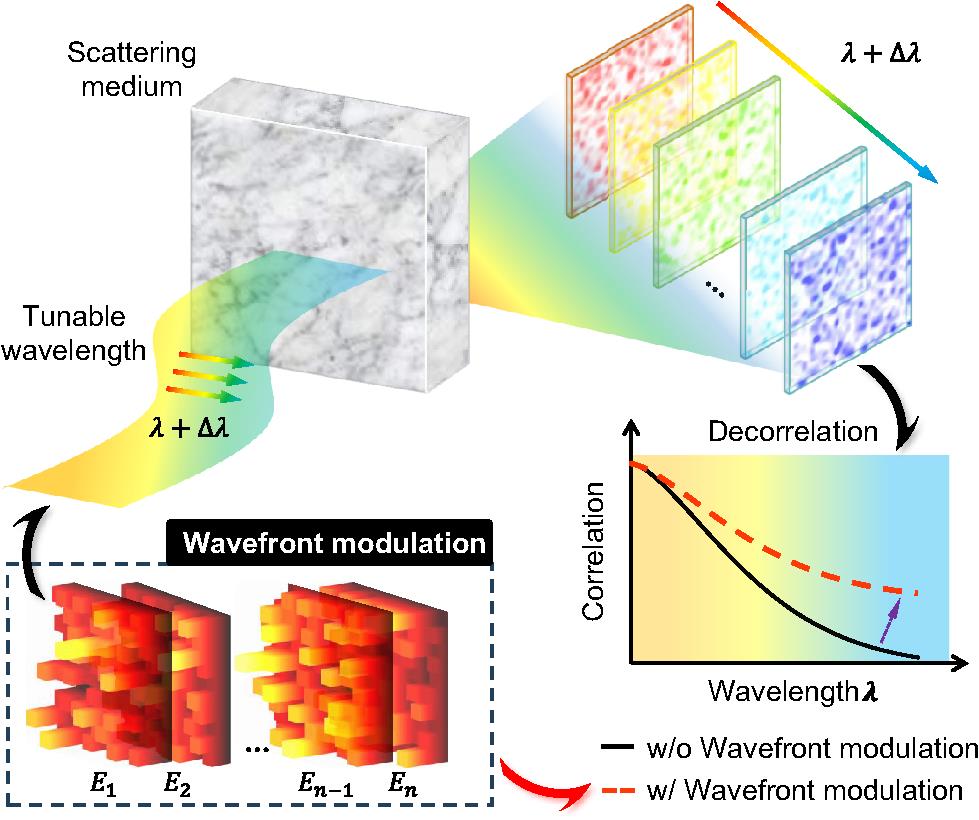Daixuan Wu, Jinye Du, Yuecheng Shen, Jiawei Luo, Zhengyang Wang, Jiaming Liang, Zhiling Zhang, Dalong Qi, Yunhua Yao, Lianzhong Deng, Meng Liu, Zhenrong Sun, Zhi-Chao Luo, Shian Zhang, "Active manipulation of the optical spectral memory effect via scattering eigenchannels," Adv. Photon. Nexus 4, 026013 (2025)
Search by keywords or author
- Advanced Photonics Nexus
- Vol. 4, Issue 2, 026013 (2025)

Fig. 1. Principal diagram of the spectral memory effect of a scattering medium. As detuning wavelengths increase, scattering characteristics evolve, leading to a decrease in the intensity correlation curve (solid black line, bottom right corner). Active wavefront modulation (bottom left corner) may significantly alter this decay (red dashed line, bottom right corner), indicating an enhanced spectral memory effect.

Fig. 2. FDTD simulation results of the spectral memory effect with excited scattering eigenchannels. The procedure begins with the characterization of a
Fig. 3. Experimental setup of a nonholographic system with a tunable spectrum. This setup enables the nonholographic determination of the scattering matrix via phase-retrieval methods, facilitating the arrangement for the investigation of the relationship between the spectral memory effect and the coupling into eigenchannels. Tunable laser, ranges from 638 to 640 nm with a tuning step size of 0.1 nm; M, reflection mirror; HWP, half-wave plate; PBS, polarization beam splitter; BB, beam block; L1-L2, lenses (
Fig. 4. Experimental results of the spectral memory effect with excited scattering eigenchannels. The scattering matrix for a piece of resin with embedded powder was characterized by a dimension of
Fig. 5. Simulation results of the spectral memory effect under practical conditions. The effects of absorption and finite bandwidth are individually explored. In the baseline scenario, the scattering medium has a thickness of
Fig. 6. Schematic diagram of the FDTD simulation framework and results. (a) Visual representation of the FDTD simulation setup for the scattering medium. The structure incorporates numerous cylinders within a confined space, simulating the medium’s scattering properties. The boundaries are designed to perfectly absorb outgoing waves, ensuring an accurate depiction of wave propagation and scattering. (b) Absorption model correlation functions: displaying correlation coefficients as functions of scattering channel count for three detuning wavelengths (2, 4, and 6 nm). This graph provides evidence of how the spectral memory effect varies under the influence of material absorption within the scattering medium, showcasing different trends for each wavelength. (c) Finite bandwidth model correlation functions: exhibiting correlation coefficients across scattering channel counts for the same set of detuning wavelengths (2, 4, and 6 nm), under the finite bandwidth illumination scenario. This segment demonstrates the impact of bandwidth constraints on the spectral memory effect, highlighting how finite bandwidth can modulate the effect across different scattering channels.

Set citation alerts for the article
Please enter your email address



